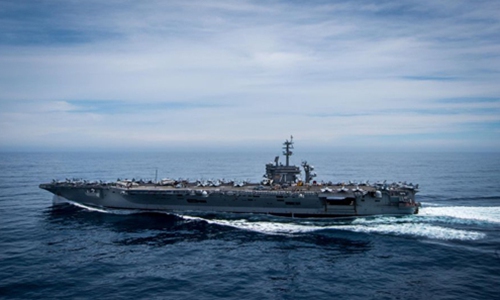US Navy's deployment of 3 aircraft carriers to Pacific a mere show of vanity
Source:Global Times Published: 2020/6/14 21:23:41

USS Theodore Roosevelt transits the Pacific Ocean on April 7, 2017. Photo: US Navy
Editor's Note:The US mobilized three aircraft carriers - USS Theodore Roosevelt, USS Nimitz and the USS Ronald Reagan - to patrol the Indo-Pacific waters, an act seen as a "warning" to China. The strike group warships were spread out on Thursday, of which USS Theodore Roosevelt and its strike group are operating near Guam, USS Nimitz strike group is in the Pacific off the US West Coast, and USS Ronald Reagan is operating in the Philippine Sea. How to interpret this move? How can China move to counteract? Global Times reporters talked to two Chinese experts on the issues.
Zhang Junshe, a senior research fellow at the PLA Naval Military Studies Research Institute
The last time the US Navy sent three aircraft carriers to this region at the same time was 2017.
Although it's not a common practice to deploy three US aircraft carriers in the West Pacific, it happened before - so this is not fresh news.
The US Navy deploys its carrier strike groups throughout the world. But it is usually not covered heavily in the news. The high-profile media exposure this time is noteworthy as it embodies the US' lack of confidence.
They seem to worry that the outside world is doubting their military capability. Therefore, the US Navy decided to send its carrier strike groups to flex muscles in the West Pacific region, exhibiting to other countries that their combat capability was ultimately not hindered by the novel coronavirus pandemic.
As a matter of fact, the morale and the combat capability of these US aircraft carriers have certainly been influenced by the pandemic. Some of the infected soldiers may have not fully recovered, and cannot return to their posts. The US Navy is just puffing itself up at its own cost. It is utterly unnecessary to dispatch carrier groups to the West Pacific when the US is hit hard by the pandemic.
The US is reluctant to release to what degree the pandemic has impacted the US Navy. As a country who always blames China and Russia over transparency in military affairs, the US intelligence over its own military is highly opaque and secret - a classic US double-standard evident to all.
Furthermore, the US deployment of these aircraft carriers is likely nothing more than posturing over security with other strong powers such as China and Russia.
It is widely seen that as the US economy still struggles to recover from impact of the pandemic, the military has become a pillar of the US in its competition with other powers. Neither Beijing nor Moscow is willing to compete with Washington with its new cold war baiting. Such practices will negatively impact global peace and stability.
Some experts are analyzing for what reason the three aircraft carriers might enter Chinese waters at the same time and what kind of threat it may pose to China. Speculation is unnecessary, as even if they come, it is no more than a muscle-flexing exercise aimed at creating tensions.
Wei Dongxu, a Beijing-based military analyst
The US Navy has deployed three nuclear-powered aircraft carriers to the Indo-Pacific waters. However, the three carriers may not simultaneously appear around China because such a move will send a very dangerous signal, triggering tensions in the region.
However, the US Navy may deploy one aircraft carrier each time around China to provoke it. For example, the US may first deploy an aircraft carrier near China and the other two may carry out activities in peripheral areas. Through such rotation, the US can make its aircraft carriers frequently appear near China's doorsteps.
These aircraft carriers are dependent on their aircraft squadrons as a deterrence.
The US might even dispatch carrier-based aircraft from great distances. For example, the US may send the carrier-based multirole fighter Boeing F/A-18E/F Super Hornet, or the F-35C stealth fighter to show off its muscle.
To cope with the US' carrier-based aircraft, China must develop integrated warning systems for land, sea and air. For example, China can use early warning and control aircraft to patrol. Once it finds that the US makes provocative actions or is moving closer to China's airspace, it can send out more advanced fighters to intercept them. The US may deploy more F-35C stealth fighters in the future. This requires more advanced technology to detect and track them, such as anti-stealth radar. Preventing stealth aircraft and stealth drones should be our main task in terms of preventing air and marine provocations.
The raging COVID-19 pandemic will, to a great extent, restrain the US Navy's mobilization. COVID-19 broke out on USS Theodore Roosevelt in March, and the US Navy's combat capability has not completely been restored yet. Under such circumstances, the US hastily dispatched aircraft carriers to carry out frequent activities in the Pacific. This may lead to a second outbreak of the coronavirus among its aircraft carriers. Officers and soldiers of the US Navy may face more risks of being infected. The US' showing off its muscle may backfire this time.
Posted in: VIEWPOINT,CHINA-US